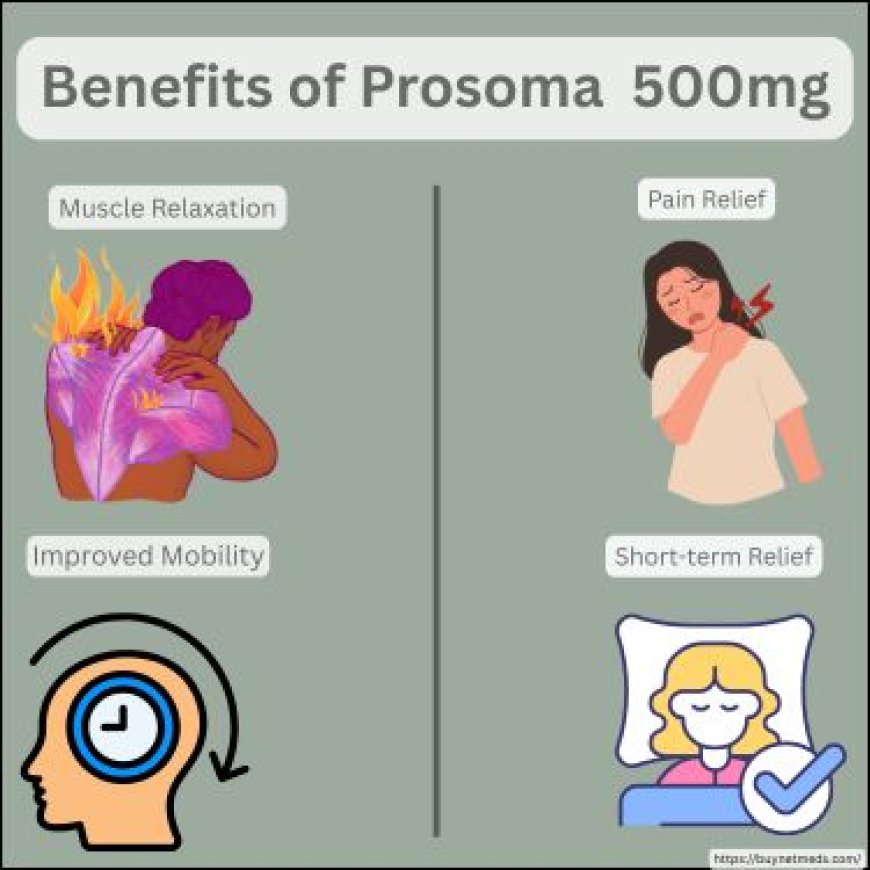Muscle Relaxants: Mechanisms and Benefits in Pain and Spasm Management
Discover how Prosoma 500 (Carisoprodol) works as a muscle relaxant—relieving pain, spasms & stiffness. Learn its benefits, mechanism, and safe usage guidelines

Muscle relaxants play a crucial role in managing acute musculoskeletal pain and spasms. Among these, Prosoma 500 (containing Carisoprodol) stands out as an effective prescription medication for short-term relief. This article explores the mechanisms, benefits, and therapeutic uses of Prosoma 500, detailing how it helps with muscle relaxation, pain relief, and improved mobility.
1. How Prosoma 500 Works: Mechanism of Action
Prosoma 500mghasCarisoprodol, acentralmuscle relaxant.Incontrast todirect muscle paralyzers (e.g.,neuromuscular blockers), Carisoprodolactson the central nervous system (CNS),the brain and spinal cord, tochangepain perception andmuscle hyperactivity.
MajorMechanisms:
Modulates GABA Receptors: Carisoprodolincreasestheactionof gamma-aminobutyric acid (GABA),theinhibitory neurotransmitter thatsoothesoveractive nerveimpulsescausingmuscle spasms.
Interrupts PainSignal:Throughdepressing neuronal activity in the reticular formation and spinal cord, itdiminishespainsensation.
Sedative Effect:Throughmildsedation,itrelaxestense muscles bycreatingasoothingeffect.
Why Prosoma 500?
Quickaction(effectswithin 30 minutes to an hour).
Goodfor acuteasopposedtochroniccases.
Usuallyprescribedwithrest, physical therapy, andanalgesicsforenhancedeffectiveness.
2. Muscle Relaxation: How Prosoma 500AlleviatesSpasms and Stiffness
Musclestiffnessandspasmsareusuallycausedby injury,strain, ordisorderssuchasfibromyalgia, back pain, or cervical spondylosis. Prosoma 500alleviatestheseby:
Breaking the Spasm-Pain Cycle
Pain results frommuscle spasms,inducingmore tension and stiffness.
Carisoprodolbreaksthis cycle by relaxing skeletal musclessothattheycanrevertto normalfunctioning.
Conditions Where Prosoma 500 isHelpful:
Acute back pain (e.g., lumbar strain)
Neck pain (whiplash, cervical muscle spasm)
Post-surgical muscle stiffness
Fibromyalgia-related muscle tension
Clinical Benefit:
Involuntarycontractionsareminimized,somovingisless difficultwithout the constantdragofcontractedmuscles.
3. Pain Relief: How Prosoma 500EasesPain
Spasm-inducedpaincan beincapacitating, but Prosoma 500easesthesufferingby:
Dual-Action Approach
Direct Muscle Relaxation Reducestensionon nerves andthesurrounding tissues.
Central Pain Modulation Changesthewaythe brainunderstandspain signals.
Effectiveness in Different Pain Types:
Musculoskeletal Pain:Duetoinjuryor overuse (e.g., herniated disc, sciatica).
Post-Traumatic Pain:Followingaccidents or fractures,whenmusclesgointodefensive tension.
Arthritis-Related Stiffness:Assistwith secondary muscle tightness.
Why Short-Term Use?
Risk of dependence iftakenlong-term (Carisoprodolismetabolizedinto meprobamate, a controlled substance).
Bestusedfor 2-3 weeksincombination withphysical therapy.
4. Improved Mobility: Restoring Range of Motion
Withrelaxedmuscles, patientsrestore:
Greaterflexibility (lessstiffness).
Improvedmovement (less guarding or protective tension).
Morerapidrecovery whenusedwith stretching/exercise.
How Prosoma 500AssistsMobility:
Decreasesmuscle guarding (automaticcontractiondue to pain).
Facilitateslightrehabilitation
exerciseswithlittlediscomfort.
Avoidssecondary stiffness fromextendedimmobility.
Patient Example:
Apatientwith acute lower back painmaybeunableto bend or walk. With Prosoma 500, muscle relaxationfacilitatesgradual movement,acceleratingrecovery.
5. Short-Term Use: Why Prosoma 500 is Not for Long-Term Management
Thoughextremelyeffective, Prosoma 500 isonlyusedfor shorperiodsme(usually2-3 weeks)becauseof:
PossibleDangersof Prolonged Use:
Tolerance & Dependence: Carisoprodolishabit-forming.
Sedation Side Effects: Drowsiness, dizziness (affectsdriving/alertness).
Withdrawal Symptoms: Anxiety, tremors, or insomniawhenabruptlydiscontinued.
BestUseGuidelines:
? For acute flare-ups (not chronic pain).
?Incombinationwith rest, ice/heattreatment, andmildstretching.
?Donot usealcoholorCNS depressants (increasesrisk ofsedation).
Conclusion: The Role of Prosoma 500 in Muscle Spasm and PainRelief
Prosoma 500 (Carisoprodol) is aquick, short-termreliefmedicationfor muscle spasms, pain, and stiffness.Throughitspotentiation ofGABA activity andinhibitionofCNS hyperexcitability, itisableto disruptthe pain-spasm cycle,enhancemobility, andaidrecovery.Nevertheless,becauseofitsriskfor dependence, it should betakenonly asdirectedandincombination withnon-drugtreatmentssuchasphysiotherapy.
Forpatientswithacute musculoskeletalillness, Prosoma 500providesausefulwindow ofrespite, enablingthe body torecoverwhilemaintainingcomfort andmobility.
Final Takeaways:
? Prosoma 500functionsby modulating GABA andsoothinghyperactivenerves.
? Relieves muscle spasms, stiffness, andrelatedpain.
?Enhancesmobility byalleviatingmuscle guarding.
?Usageforonlya short term(2-3 weeks) topreventdependence.
?Optimalwhenusedwith physical therapy forsustainedrecovery.










































